Comprehensive Analysis of Statistical Research Methodology Report
VerifiedAdded on 2023/04/25
|8
|2084
|489
Report
AI Summary
This report provides a detailed analysis of a research study, focusing on its theoretical rationale, research gap, and the importance of the research. It examines the study's purpose, hypothesis, and the identification of dependent and independent variables. The report also delves into the operationalization of variables, the use of primary and secondary sources, and the demographics of the research participants. It further discusses the sampling method, sample size, and generalizability of the research findings. The analysis extends to the research design, data collection methods, informed consent process, and the level of significance in hypothesis testing. Finally, the report evaluates the validity and reliability of the measurement tools used in the study, along with the application of descriptive and inferential statistics.

Running Head: STATISTICS. 1
STATISTICS.
Name:
Institution:
Date:
STATISTICS.
Name:
Institution:
Date:
Paraphrase This Document
Need a fresh take? Get an instant paraphrase of this document with our AI Paraphraser
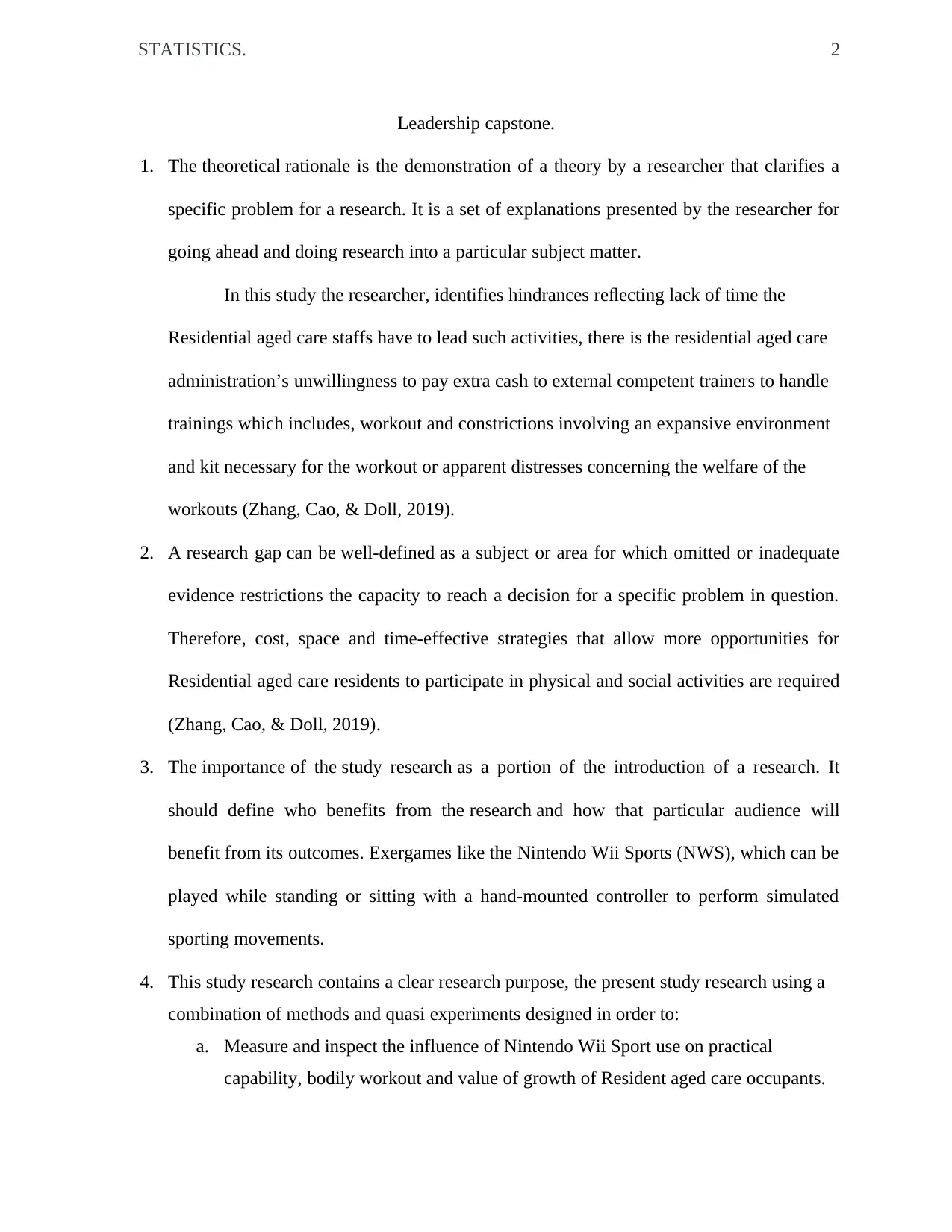
STATISTICS. 2
Leadership capstone.
1. The theoretical rationale is the demonstration of a theory by a researcher that clarifies a
specific problem for a research. It is a set of explanations presented by the researcher for
going ahead and doing research into a particular subject matter.
In this study the researcher, identifies hindrances reflecting lack of time the
Residential aged care staffs have to lead such activities, there is the residential aged care
administration’s unwillingness to pay extra cash to external competent trainers to handle
trainings which includes, workout and constrictions involving an expansive environment
and kit necessary for the workout or apparent distresses concerning the welfare of the
workouts (Zhang, Cao, & Doll, 2019).
2. A research gap can be well-defined as a subject or area for which omitted or inadequate
evidence restrictions the capacity to reach a decision for a specific problem in question.
Therefore, cost, space and time-effective strategies that allow more opportunities for
Residential aged care residents to participate in physical and social activities are required
(Zhang, Cao, & Doll, 2019).
3. The importance of the study research as a portion of the introduction of a research. It
should define who benefits from the research and how that particular audience will
benefit from its outcomes. Exergames like the Nintendo Wii Sports (NWS), which can be
played while standing or sitting with a hand-mounted controller to perform simulated
sporting movements.
4. This study research contains a clear research purpose, the present study research using a
combination of methods and quasi experiments designed in order to:
a. Measure and inspect the influence of Nintendo Wii Sport use on practical
capability, bodily workout and value of growth of Resident aged care occupants.
Leadership capstone.
1. The theoretical rationale is the demonstration of a theory by a researcher that clarifies a
specific problem for a research. It is a set of explanations presented by the researcher for
going ahead and doing research into a particular subject matter.
In this study the researcher, identifies hindrances reflecting lack of time the
Residential aged care staffs have to lead such activities, there is the residential aged care
administration’s unwillingness to pay extra cash to external competent trainers to handle
trainings which includes, workout and constrictions involving an expansive environment
and kit necessary for the workout or apparent distresses concerning the welfare of the
workouts (Zhang, Cao, & Doll, 2019).
2. A research gap can be well-defined as a subject or area for which omitted or inadequate
evidence restrictions the capacity to reach a decision for a specific problem in question.
Therefore, cost, space and time-effective strategies that allow more opportunities for
Residential aged care residents to participate in physical and social activities are required
(Zhang, Cao, & Doll, 2019).
3. The importance of the study research as a portion of the introduction of a research. It
should define who benefits from the research and how that particular audience will
benefit from its outcomes. Exergames like the Nintendo Wii Sports (NWS), which can be
played while standing or sitting with a hand-mounted controller to perform simulated
sporting movements.
4. This study research contains a clear research purpose, the present study research using a
combination of methods and quasi experiments designed in order to:
a. Measure and inspect the influence of Nintendo Wii Sport use on practical
capability, bodily workout and value of growth of Resident aged care occupants.
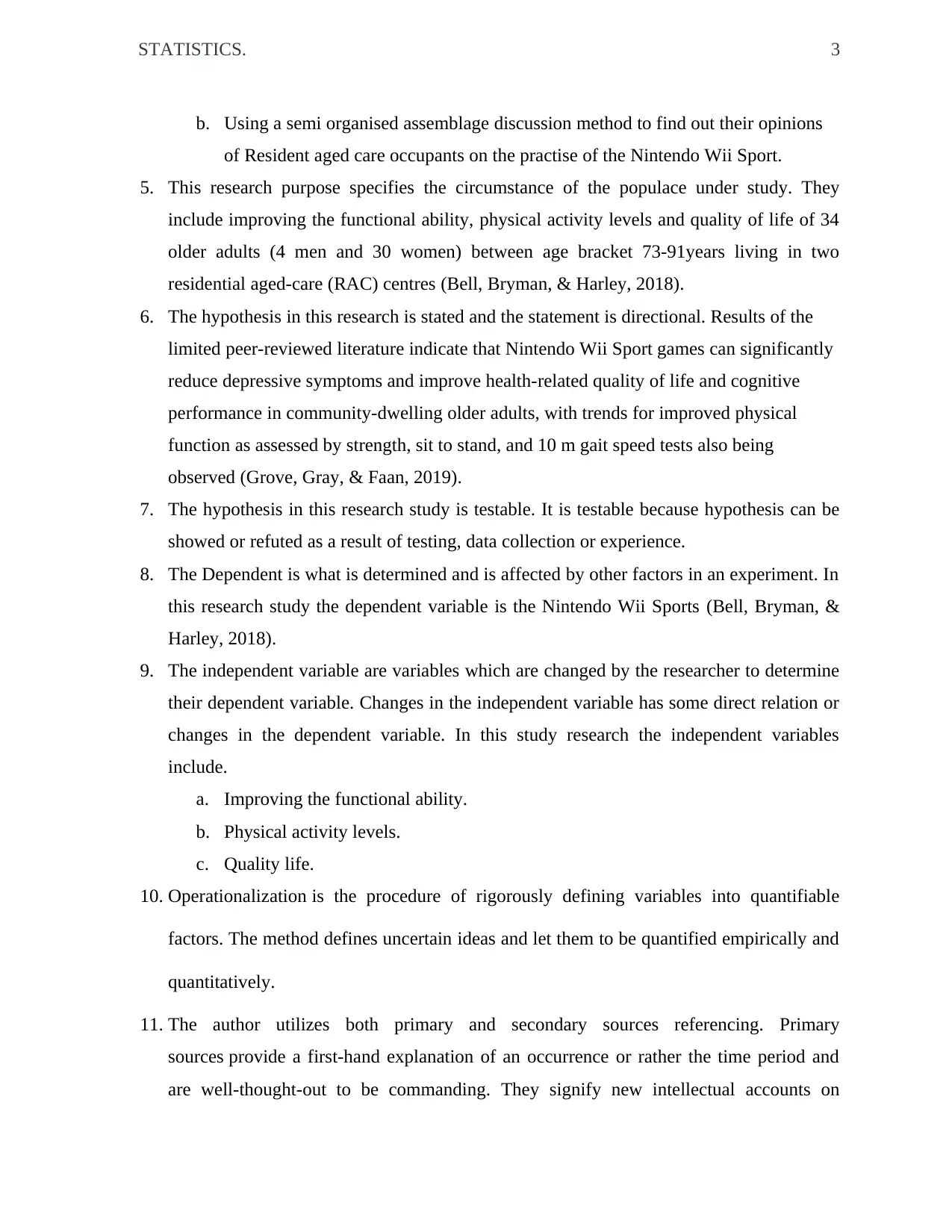
STATISTICS. 3
b. Using a semi organised assemblage discussion method to find out their opinions
of Resident aged care occupants on the practise of the Nintendo Wii Sport.
5. This research purpose specifies the circumstance of the populace under study. They
include improving the functional ability, physical activity levels and quality of life of 34
older adults (4 men and 30 women) between age bracket 73-91years living in two
residential aged-care (RAC) centres (Bell, Bryman, & Harley, 2018).
6. The hypothesis in this research is stated and the statement is directional. Results of the
limited peer-reviewed literature indicate that Nintendo Wii Sport games can significantly
reduce depressive symptoms and improve health-related quality of life and cognitive
performance in community-dwelling older adults, with trends for improved physical
function as assessed by strength, sit to stand, and 10 m gait speed tests also being
observed (Grove, Gray, & Faan, 2019).
7. The hypothesis in this research study is testable. It is testable because hypothesis can be
showed or refuted as a result of testing, data collection or experience.
8. The Dependent is what is determined and is affected by other factors in an experiment. In
this research study the dependent variable is the Nintendo Wii Sports (Bell, Bryman, &
Harley, 2018).
9. The independent variable are variables which are changed by the researcher to determine
their dependent variable. Changes in the independent variable has some direct relation or
changes in the dependent variable. In this study research the independent variables
include.
a. Improving the functional ability.
b. Physical activity levels.
c. Quality life.
10. Operationalization is the procedure of rigorously defining variables into quantifiable
factors. The method defines uncertain ideas and let them to be quantified empirically and
quantitatively.
11. The author utilizes both primary and secondary sources referencing. Primary
sources provide a first-hand explanation of an occurrence or rather the time period and
are well-thought-out to be commanding. They signify new intellectual accounts on
b. Using a semi organised assemblage discussion method to find out their opinions
of Resident aged care occupants on the practise of the Nintendo Wii Sport.
5. This research purpose specifies the circumstance of the populace under study. They
include improving the functional ability, physical activity levels and quality of life of 34
older adults (4 men and 30 women) between age bracket 73-91years living in two
residential aged-care (RAC) centres (Bell, Bryman, & Harley, 2018).
6. The hypothesis in this research is stated and the statement is directional. Results of the
limited peer-reviewed literature indicate that Nintendo Wii Sport games can significantly
reduce depressive symptoms and improve health-related quality of life and cognitive
performance in community-dwelling older adults, with trends for improved physical
function as assessed by strength, sit to stand, and 10 m gait speed tests also being
observed (Grove, Gray, & Faan, 2019).
7. The hypothesis in this research study is testable. It is testable because hypothesis can be
showed or refuted as a result of testing, data collection or experience.
8. The Dependent is what is determined and is affected by other factors in an experiment. In
this research study the dependent variable is the Nintendo Wii Sports (Bell, Bryman, &
Harley, 2018).
9. The independent variable are variables which are changed by the researcher to determine
their dependent variable. Changes in the independent variable has some direct relation or
changes in the dependent variable. In this study research the independent variables
include.
a. Improving the functional ability.
b. Physical activity levels.
c. Quality life.
10. Operationalization is the procedure of rigorously defining variables into quantifiable
factors. The method defines uncertain ideas and let them to be quantified empirically and
quantitatively.
11. The author utilizes both primary and secondary sources referencing. Primary
sources provide a first-hand explanation of an occurrence or rather the time period and
are well-thought-out to be commanding. They signify new intellectual accounts on
⊘ This is a preview!⊘
Do you want full access?
Subscribe today to unlock all pages.

Trusted by 1+ million students worldwide
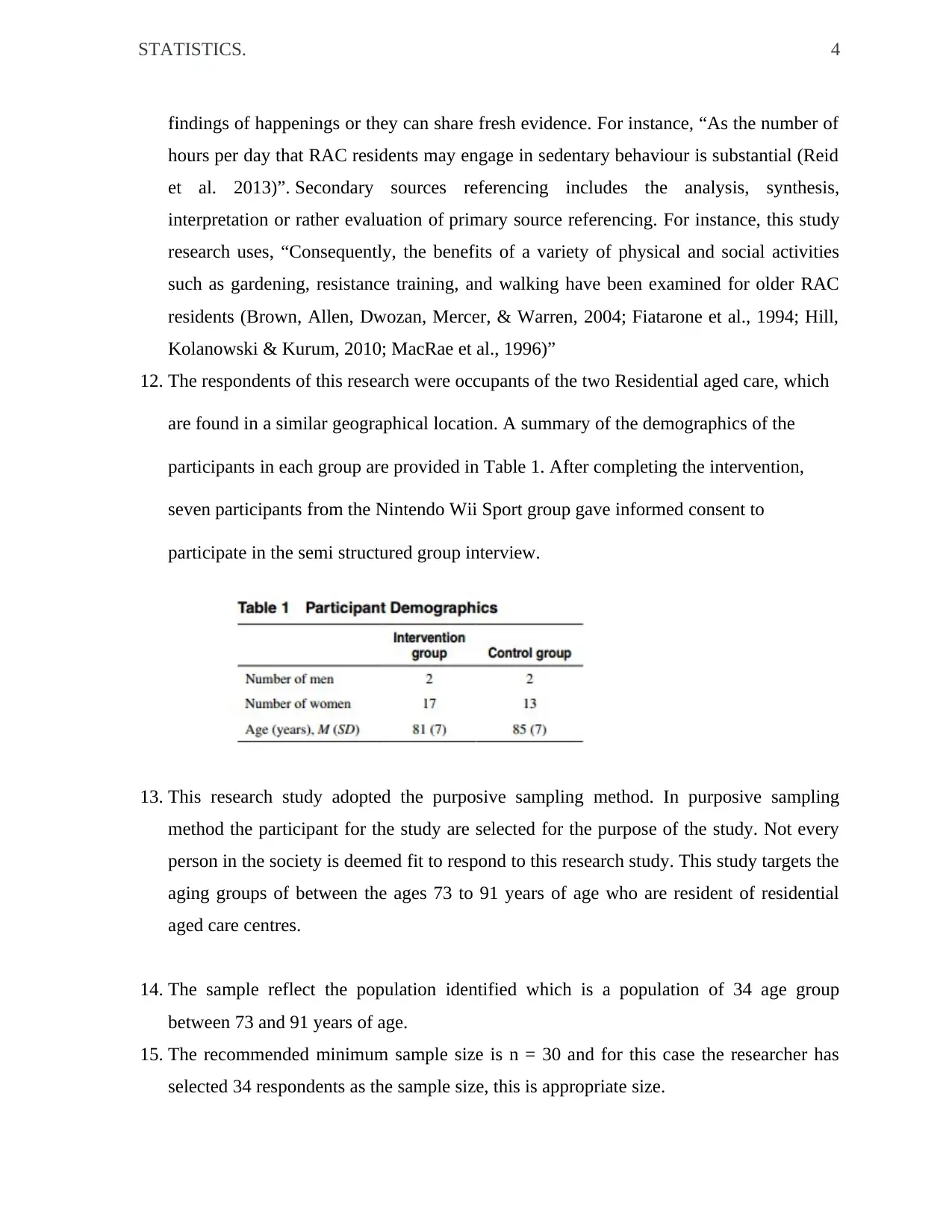
STATISTICS. 4
findings of happenings or they can share fresh evidence. For instance, “As the number of
hours per day that RAC residents may engage in sedentary behaviour is substantial (Reid
et al. 2013)”. Secondary sources referencing includes the analysis, synthesis,
interpretation or rather evaluation of primary source referencing. For instance, this study
research uses, “Consequently, the benefits of a variety of physical and social activities
such as gardening, resistance training, and walking have been examined for older RAC
residents (Brown, Allen, Dwozan, Mercer, & Warren, 2004; Fiatarone et al., 1994; Hill,
Kolanowski & Kurum, 2010; MacRae et al., 1996)”
12. The respondents of this research were occupants of the two Residential aged care, which
are found in a similar geographical location. A summary of the demographics of the
participants in each group are provided in Table 1. After completing the intervention,
seven participants from the Nintendo Wii Sport group gave informed consent to
participate in the semi structured group interview.
13. This research study adopted the purposive sampling method. In purposive sampling
method the participant for the study are selected for the purpose of the study. Not every
person in the society is deemed fit to respond to this research study. This study targets the
aging groups of between the ages 73 to 91 years of age who are resident of residential
aged care centres.
14. The sample reflect the population identified which is a population of 34 age group
between 73 and 91 years of age.
15. The recommended minimum sample size is n = 30 and for this case the researcher has
selected 34 respondents as the sample size, this is appropriate size.
findings of happenings or they can share fresh evidence. For instance, “As the number of
hours per day that RAC residents may engage in sedentary behaviour is substantial (Reid
et al. 2013)”. Secondary sources referencing includes the analysis, synthesis,
interpretation or rather evaluation of primary source referencing. For instance, this study
research uses, “Consequently, the benefits of a variety of physical and social activities
such as gardening, resistance training, and walking have been examined for older RAC
residents (Brown, Allen, Dwozan, Mercer, & Warren, 2004; Fiatarone et al., 1994; Hill,
Kolanowski & Kurum, 2010; MacRae et al., 1996)”
12. The respondents of this research were occupants of the two Residential aged care, which
are found in a similar geographical location. A summary of the demographics of the
participants in each group are provided in Table 1. After completing the intervention,
seven participants from the Nintendo Wii Sport group gave informed consent to
participate in the semi structured group interview.
13. This research study adopted the purposive sampling method. In purposive sampling
method the participant for the study are selected for the purpose of the study. Not every
person in the society is deemed fit to respond to this research study. This study targets the
aging groups of between the ages 73 to 91 years of age who are resident of residential
aged care centres.
14. The sample reflect the population identified which is a population of 34 age group
between 73 and 91 years of age.
15. The recommended minimum sample size is n = 30 and for this case the researcher has
selected 34 respondents as the sample size, this is appropriate size.
Paraphrase This Document
Need a fresh take? Get an instant paraphrase of this document with our AI Paraphraser
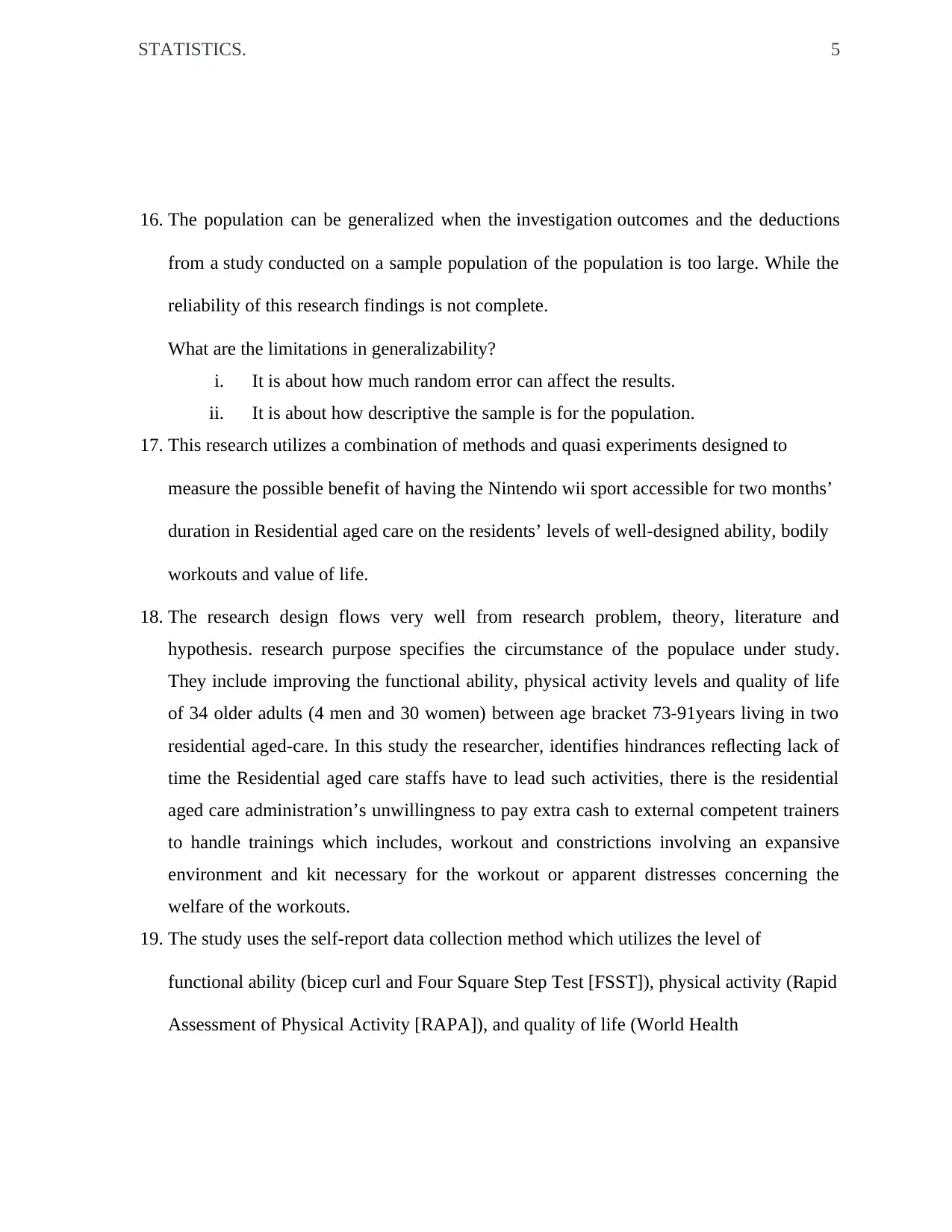
STATISTICS. 5
16. The population can be generalized when the investigation outcomes and the deductions
from a study conducted on a sample population of the population is too large. While the
reliability of this research findings is not complete.
What are the limitations in generalizability?
i. It is about how much random error can affect the results.
ii. It is about how descriptive the sample is for the population.
17. This research utilizes a combination of methods and quasi experiments designed to
measure the possible benefit of having the Nintendo wii sport accessible for two months’
duration in Residential aged care on the residents’ levels of well-designed ability, bodily
workouts and value of life.
18. The research design flows very well from research problem, theory, literature and
hypothesis. research purpose specifies the circumstance of the populace under study.
They include improving the functional ability, physical activity levels and quality of life
of 34 older adults (4 men and 30 women) between age bracket 73-91years living in two
residential aged-care. In this study the researcher, identifies hindrances reflecting lack of
time the Residential aged care staffs have to lead such activities, there is the residential
aged care administration’s unwillingness to pay extra cash to external competent trainers
to handle trainings which includes, workout and constrictions involving an expansive
environment and kit necessary for the workout or apparent distresses concerning the
welfare of the workouts.
19. The study uses the self-report data collection method which utilizes the level of
functional ability (bicep curl and Four Square Step Test [FSST]), physical activity (Rapid
Assessment of Physical Activity [RAPA]), and quality of life (World Health
16. The population can be generalized when the investigation outcomes and the deductions
from a study conducted on a sample population of the population is too large. While the
reliability of this research findings is not complete.
What are the limitations in generalizability?
i. It is about how much random error can affect the results.
ii. It is about how descriptive the sample is for the population.
17. This research utilizes a combination of methods and quasi experiments designed to
measure the possible benefit of having the Nintendo wii sport accessible for two months’
duration in Residential aged care on the residents’ levels of well-designed ability, bodily
workouts and value of life.
18. The research design flows very well from research problem, theory, literature and
hypothesis. research purpose specifies the circumstance of the populace under study.
They include improving the functional ability, physical activity levels and quality of life
of 34 older adults (4 men and 30 women) between age bracket 73-91years living in two
residential aged-care. In this study the researcher, identifies hindrances reflecting lack of
time the Residential aged care staffs have to lead such activities, there is the residential
aged care administration’s unwillingness to pay extra cash to external competent trainers
to handle trainings which includes, workout and constrictions involving an expansive
environment and kit necessary for the workout or apparent distresses concerning the
welfare of the workouts.
19. The study uses the self-report data collection method which utilizes the level of
functional ability (bicep curl and Four Square Step Test [FSST]), physical activity (Rapid
Assessment of Physical Activity [RAPA]), and quality of life (World Health
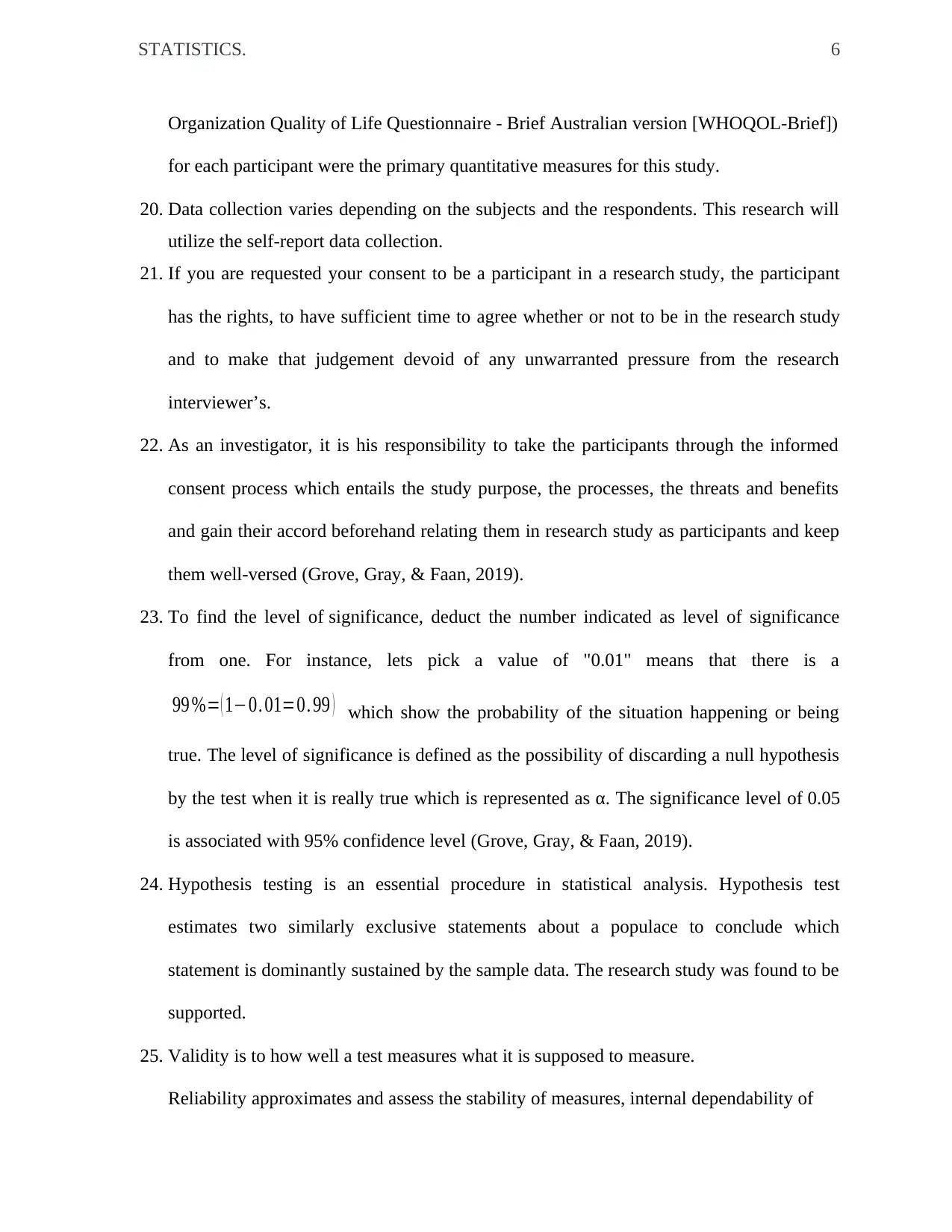
STATISTICS. 6
Organization Quality of Life Questionnaire - Brief Australian version [WHOQOL-Brief])
for each participant were the primary quantitative measures for this study.
20. Data collection varies depending on the subjects and the respondents. This research will
utilize the self-report data collection.
21. If you are requested your consent to be a participant in a research study, the participant
has the rights, to have sufficient time to agree whether or not to be in the research study
and to make that judgement devoid of any unwarranted pressure from the research
interviewer’s.
22. As an investigator, it is his responsibility to take the participants through the informed
consent process which entails the study purpose, the processes, the threats and benefits
and gain their accord beforehand relating them in research study as participants and keep
them well-versed (Grove, Gray, & Faan, 2019).
23. To find the level of significance, deduct the number indicated as level of significance
from one. For instance, lets pick a value of "0.01" means that there is a
99 %= ( 1−0. 01=0. 99 ) which show the probability of the situation happening or being
true. The level of significance is defined as the possibility of discarding a null hypothesis
by the test when it is really true which is represented as α. The significance level of 0.05
is associated with 95% confidence level (Grove, Gray, & Faan, 2019).
24. Hypothesis testing is an essential procedure in statistical analysis. Hypothesis test
estimates two similarly exclusive statements about a populace to conclude which
statement is dominantly sustained by the sample data. The research study was found to be
supported.
25. Validity is to how well a test measures what it is supposed to measure.
Reliability approximates and assess the stability of measures, internal dependability of
Organization Quality of Life Questionnaire - Brief Australian version [WHOQOL-Brief])
for each participant were the primary quantitative measures for this study.
20. Data collection varies depending on the subjects and the respondents. This research will
utilize the self-report data collection.
21. If you are requested your consent to be a participant in a research study, the participant
has the rights, to have sufficient time to agree whether or not to be in the research study
and to make that judgement devoid of any unwarranted pressure from the research
interviewer’s.
22. As an investigator, it is his responsibility to take the participants through the informed
consent process which entails the study purpose, the processes, the threats and benefits
and gain their accord beforehand relating them in research study as participants and keep
them well-versed (Grove, Gray, & Faan, 2019).
23. To find the level of significance, deduct the number indicated as level of significance
from one. For instance, lets pick a value of "0.01" means that there is a
99 %= ( 1−0. 01=0. 99 ) which show the probability of the situation happening or being
true. The level of significance is defined as the possibility of discarding a null hypothesis
by the test when it is really true which is represented as α. The significance level of 0.05
is associated with 95% confidence level (Grove, Gray, & Faan, 2019).
24. Hypothesis testing is an essential procedure in statistical analysis. Hypothesis test
estimates two similarly exclusive statements about a populace to conclude which
statement is dominantly sustained by the sample data. The research study was found to be
supported.
25. Validity is to how well a test measures what it is supposed to measure.
Reliability approximates and assess the stability of measures, internal dependability of
⊘ This is a preview!⊘
Do you want full access?
Subscribe today to unlock all pages.

Trusted by 1+ million students worldwide
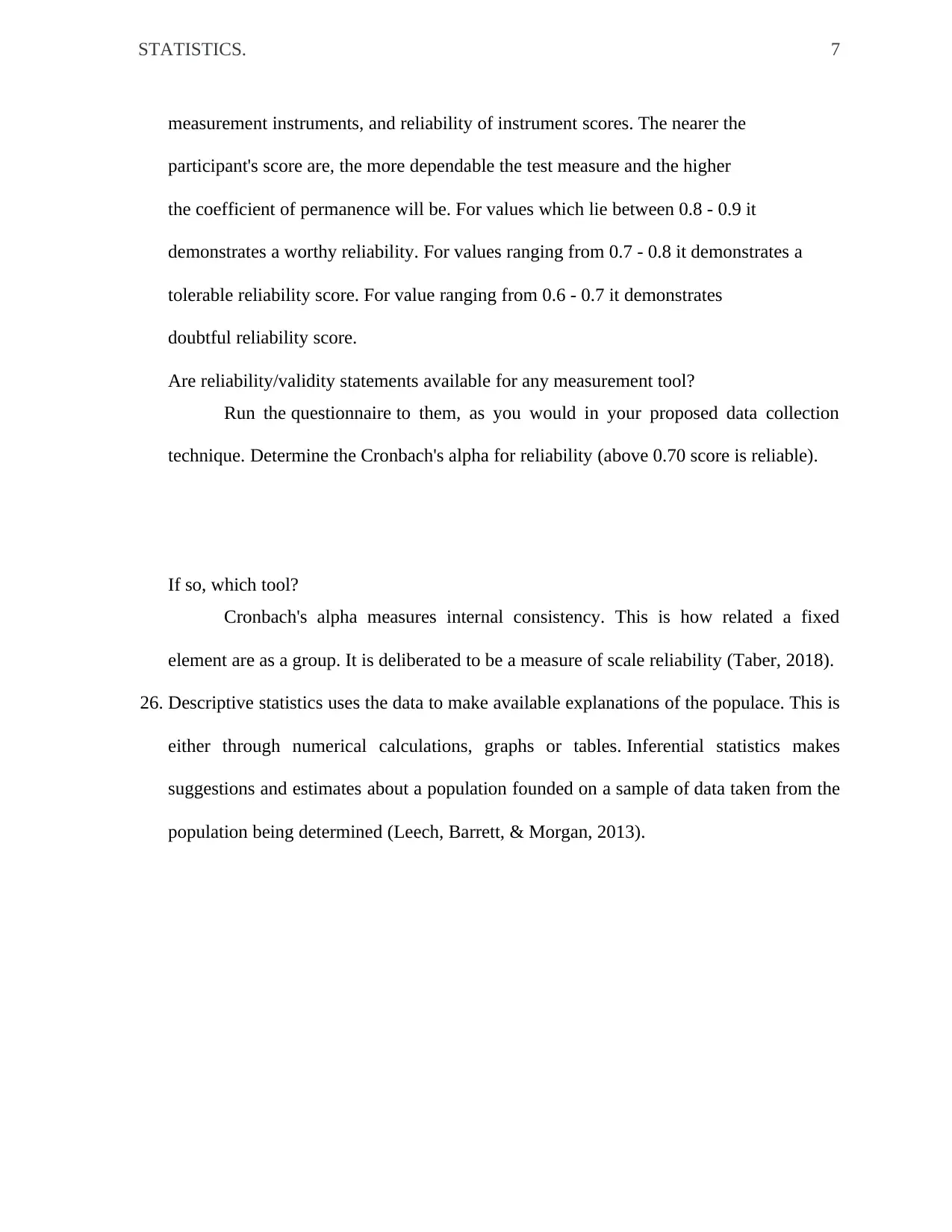
STATISTICS. 7
measurement instruments, and reliability of instrument scores. The nearer the
participant's score are, the more dependable the test measure and the higher
the coefficient of permanence will be. For values which lie between 0.8 - 0.9 it
demonstrates a worthy reliability. For values ranging from 0.7 - 0.8 it demonstrates a
tolerable reliability score. For value ranging from 0.6 - 0.7 it demonstrates
doubtful reliability score.
Are reliability/validity statements available for any measurement tool?
Run the questionnaire to them, as you would in your proposed data collection
technique. Determine the Cronbach's alpha for reliability (above 0.70 score is reliable).
If so, which tool?
Cronbach's alpha measures internal consistency. This is how related a fixed
element are as a group. It is deliberated to be a measure of scale reliability (Taber, 2018).
26. Descriptive statistics uses the data to make available explanations of the populace. This is
either through numerical calculations, graphs or tables. Inferential statistics makes
suggestions and estimates about a population founded on a sample of data taken from the
population being determined (Leech, Barrett, & Morgan, 2013).
measurement instruments, and reliability of instrument scores. The nearer the
participant's score are, the more dependable the test measure and the higher
the coefficient of permanence will be. For values which lie between 0.8 - 0.9 it
demonstrates a worthy reliability. For values ranging from 0.7 - 0.8 it demonstrates a
tolerable reliability score. For value ranging from 0.6 - 0.7 it demonstrates
doubtful reliability score.
Are reliability/validity statements available for any measurement tool?
Run the questionnaire to them, as you would in your proposed data collection
technique. Determine the Cronbach's alpha for reliability (above 0.70 score is reliable).
If so, which tool?
Cronbach's alpha measures internal consistency. This is how related a fixed
element are as a group. It is deliberated to be a measure of scale reliability (Taber, 2018).
26. Descriptive statistics uses the data to make available explanations of the populace. This is
either through numerical calculations, graphs or tables. Inferential statistics makes
suggestions and estimates about a population founded on a sample of data taken from the
population being determined (Leech, Barrett, & Morgan, 2013).
Paraphrase This Document
Need a fresh take? Get an instant paraphrase of this document with our AI Paraphraser
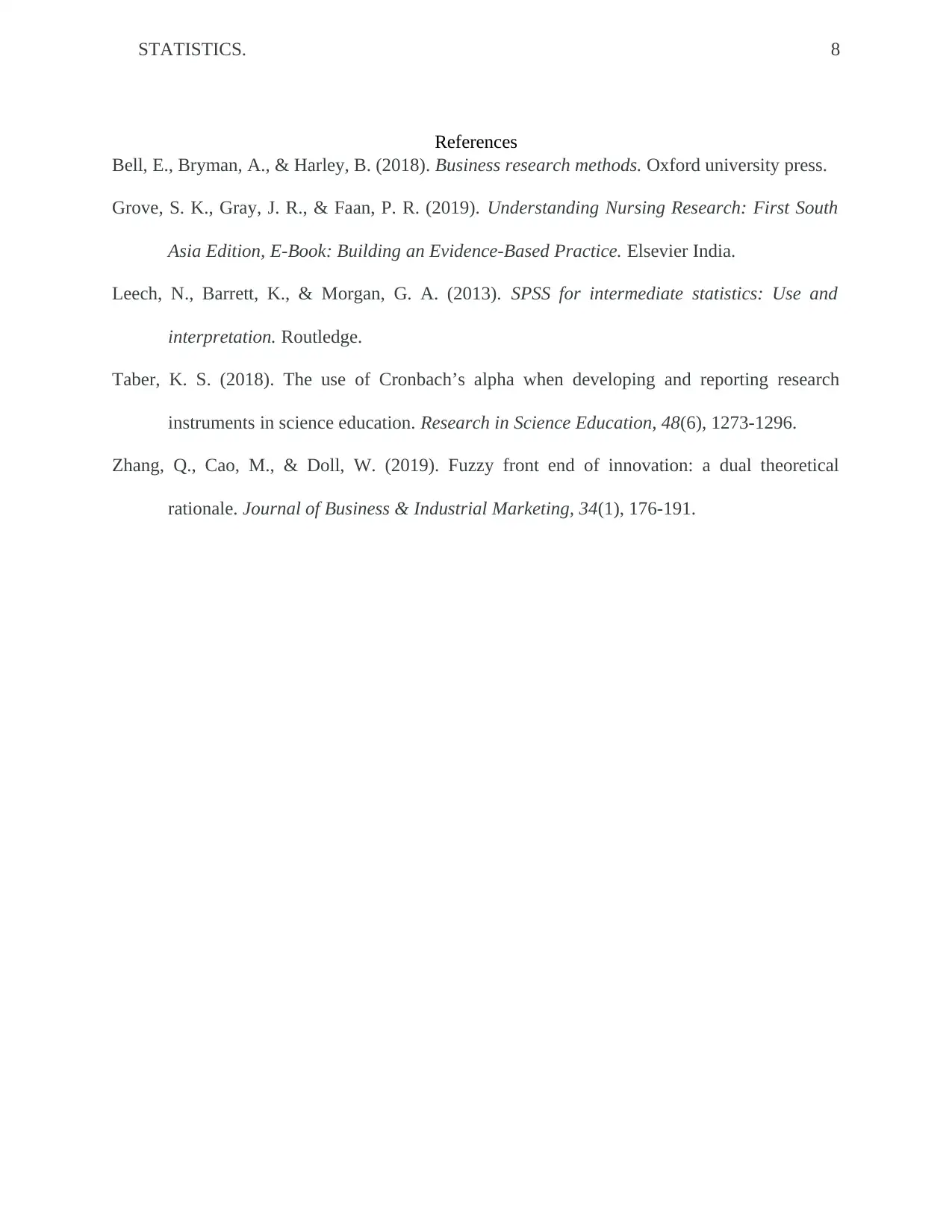
STATISTICS. 8
References
Bell, E., Bryman, A., & Harley, B. (2018). Business research methods. Oxford university press.
Grove, S. K., Gray, J. R., & Faan, P. R. (2019). Understanding Nursing Research: First South
Asia Edition, E-Book: Building an Evidence-Based Practice. Elsevier India.
Leech, N., Barrett, K., & Morgan, G. A. (2013). SPSS for intermediate statistics: Use and
interpretation. Routledge.
Taber, K. S. (2018). The use of Cronbach’s alpha when developing and reporting research
instruments in science education. Research in Science Education, 48(6), 1273-1296.
Zhang, Q., Cao, M., & Doll, W. (2019). Fuzzy front end of innovation: a dual theoretical
rationale. Journal of Business & Industrial Marketing, 34(1), 176-191.
References
Bell, E., Bryman, A., & Harley, B. (2018). Business research methods. Oxford university press.
Grove, S. K., Gray, J. R., & Faan, P. R. (2019). Understanding Nursing Research: First South
Asia Edition, E-Book: Building an Evidence-Based Practice. Elsevier India.
Leech, N., Barrett, K., & Morgan, G. A. (2013). SPSS for intermediate statistics: Use and
interpretation. Routledge.
Taber, K. S. (2018). The use of Cronbach’s alpha when developing and reporting research
instruments in science education. Research in Science Education, 48(6), 1273-1296.
Zhang, Q., Cao, M., & Doll, W. (2019). Fuzzy front end of innovation: a dual theoretical
rationale. Journal of Business & Industrial Marketing, 34(1), 176-191.
1 out of 8
Your All-in-One AI-Powered Toolkit for Academic Success.
+13062052269
info@desklib.com
Available 24*7 on WhatsApp / Email
![[object Object]](/_next/static/media/star-bottom.7253800d.svg)
Unlock your academic potential
Copyright © 2020–2025 A2Z Services. All Rights Reserved. Developed and managed by ZUCOL.